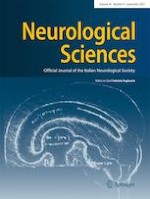Erschienen in:

17.06.2022 | Original Article
Pure word deafness: a case report of an atypical manifestation of Alzheimer’s disease
verfasst von:
Simone Salemme, Francesca Benuzzi, Luigi Fiondella, Chiara Carbone, Giulia Vinceti, Silvia Magarelli, Maria Angela Molinari, Marcella Malagoli, Giovanna Zamboni, Annalisa Chiari
Erschienen in:
Neurological Sciences
|
Ausgabe 9/2022
Einloggen, um Zugang zu erhalten
Abstract
Background
Auditory agnosia refers to the impairments in sound recognition despite intact hearing and written language abilities. When auditory agnosia is specific to spoken language, it can be indicated as pure word deafness (PWD), which is characterized by the isolated difficulty in understanding spoken language, despite preserved reading comprehension, recognition of nonverbal sounds, and production of written and spoken language.
Case
A middle-aged man with a high level of education developed a progressive speech disorder initially characterized by isolated phonemic errors during spontaneous speech and later enriched by difficulties in comprehending long sentences. The patient’s past medical history was unremarkable except for hypertension. The neuropsychological picture was suggestive of PWD, while cerebrospinal fluid (CSF) analyses lead to a biomarker-based diagnosis of Alzheimer’s disease (AD). PWD remained the prevalent cognitive deficit over the subsequent 4 years.
Conclusions
This case report shows that the presence of isolated auditory agnosia or PWD should prompt consideration of a diagnosis of AD. It also suggests that the spectrum of atypical presentations of early-onset AD may be larger than what we currently think.